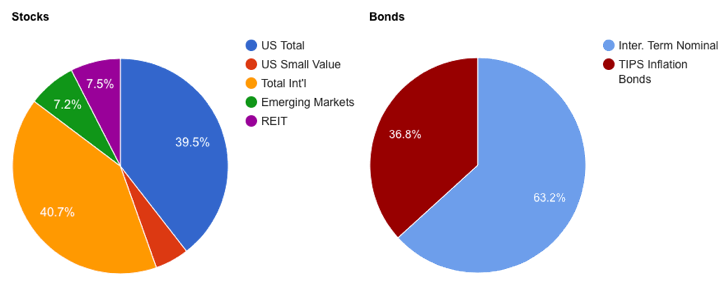
Here is an update on my investment portfolio holdings after the first quarter 2017. This includes tax-deferred accounts like 401ks, IRAs, and taxable brokerage holdings, but excludes things like our primary home, cash reserves, and a few other side investments. The purpose of this portfolio is to create enough income to cover our regular household expenses.
Target Asset Allocation
The overall goal is to include asset classes that will provide long-term returns above inflation, distribute income via dividends and interest, and finally offer some historical tendencies to balance each other out. I don’t hold commodities futures or gold as they don’t provide any income and I don’t believe they’ll outpace inflation significantly. I also believe that it is more important to have asset classes that you are confident you’ll hold through the bad times, as opposed to whatever has been doing well recently. The things that looked promising in 2000 were not the things that looked promising in 2010, and so on.
Stocks Breakdown
- 38% US Total Market
- 7% US Small-Cap Value
- 38% International Total Market
- 7% Emerging Markets
- 10% US Real Estate (REIT)
Bonds Breakdown
- 50% High-quality, intermediate-Term Bonds
- 50% US Treasury Inflation-Protected Bonds
Our current target ratio is 70% stocks and 30% bonds within our investment strategy of buy, hold, and rebalance. With a self-managed, simple portfolio of low-cost funds, we minimize management fees, commissions, and income taxes.
Actual Asset Allocation and Holdings

Stock Holdings
Vanguard Total Stock Market Fund (VTI, VTSMX, VTSAX)
Vanguard Total International Stock Market Fund (VXUS, VGTSX, VTIAX)
WisdomTree SmallCap Dividend ETF (DES)
Vanguard Small Value ETF (VBR)
Vanguard Emerging Markets ETF (VWO)
Vanguard REIT Index Fund (VNQ, VGSIX, VGSLX)
Bond Holdings
Vanguard Limited-Term Tax-Exempt Fund (VMLTX, VMLUX)
Vanguard Intermediate-Term Tax-Exempt Fund (VWITX, VWIUX)
Vanguard High-Yield Tax-Exempt Fund (VWAHX, VWALX)
Vanguard Inflation-Protected Securities Fund (VIPSX, VAIPX)
iShares Barclays TIPS Bond ETF (TIP)
Individual TIPS securities
U.S. Savings Bonds (Series I)
Commentary
In regards to my target asset allocation, I tweaked the stock percentages slightly so that I will end up with at least 5% overall in any given asset class when I reach my final ratio of roughly 65% stocks and 35% bonds in the next few years. Despite the recent outperformance of US stocks vs. the rest of the word, I am still keeping my 50/50 split between US and International holdings.
In regards to specific holdings, I did some tax-loss harvesting between my Emerging Markets and US Small Cap ETF holdings. I am also shifting towards dropping my WisdomTree ETFs and going to the more “vanilla” Vanguard versions: Vanguard Small Value ETF (VBR) and Vanguard Emerging Markets ETF (VWO). This should lower costs and increase simplicity. Otherwise, there has been little activity besides continued dollar-cost-averaging with monthly income.
I’m still somewhat underweight in TIPS and REITs mostly due to limited tax-deferred space as I really don’t want to hold them in a taxable account. My taxable muni bonds are split roughly evenly between the three Vanguard muni funds with an average duration of 4.5 years. I may start switching back to US Treasuries if my income tax rate changes signficantly.
A rough benchmark for my portfolio is 50% Vanguard LifeStrategy Growth Fund (VASGX) and 50% Vanguard LifeStrategy Moderate Growth Fund (VSMGX), one is 60/40 and one is 80/20 so it also works out to 70% stocks and 30% bonds. That benchmark would have a total return of +7.73% for 2016 and +4.96% YTD (as of 4/17/17).
So this is what I own, and in a separate post I’ll share about how I track if I have enough to retire via dividend and interest income.
 The Best Credit Card Bonus Offers – 2025
The Best Credit Card Bonus Offers – 2025 Big List of Free Stocks from Brokerage Apps
Big List of Free Stocks from Brokerage Apps Best Interest Rates on Cash - 2025
Best Interest Rates on Cash - 2025 Free Credit Scores x 3 + Free Credit Monitoring
Free Credit Scores x 3 + Free Credit Monitoring Best No Fee 0% APR Balance Transfer Offers
Best No Fee 0% APR Balance Transfer Offers Little-Known Cellular Data Plans That Can Save Big Money
Little-Known Cellular Data Plans That Can Save Big Money How To Haggle Your Cable or Direct TV Bill
How To Haggle Your Cable or Direct TV Bill Big List of Free Consumer Data Reports (Credit, Rent, Work)
Big List of Free Consumer Data Reports (Credit, Rent, Work)
Thanks for the posting, Jonathan. I appreciate your detailed review and asset allocation rationale.
Thank you, Jonathan. How did you perform compared to the benchmarked funds? Simplicity is good.
Since you have money split across accounts with different tax treatments, do you normalize and try to convert everything to an “after tax” $/% (having to make assumptions about effective tax rates)?
No, I don’t. Here’s an older post that partially explains why:
https://www.mymoneyblog.com/pay-zero-income-taxes-in-retirement.html